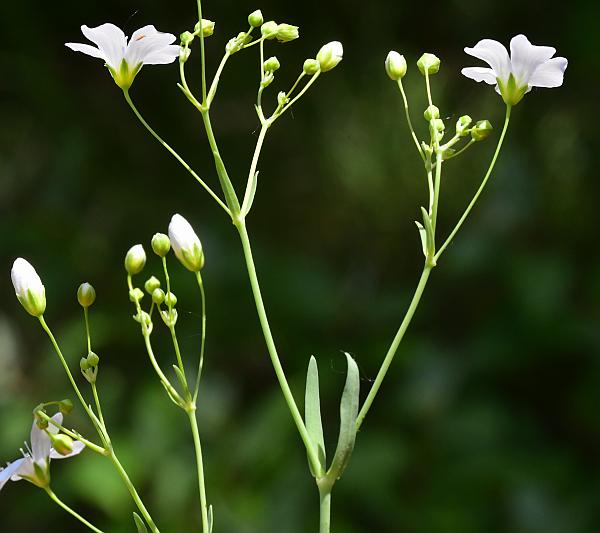Gypsophila elegans M. Bieb.
Showy Baby's Breath

Introduced
CC = *
CW =
MOC = 0
© SRTurner
Gypsophila elegans M. Bieb.Showy Baby's Breath | |
 |
Introduced CC = * CW = MOC = 0 |
© SRTurner |
|
Family - Caryophyllaceae Habit - Annual forb. Stems - Ascending to erect, to 60 cm, simple or few-branched, glabrous, glaucous.
Leaves - Opposite, simple. Lower leaves clasping, linear-lanceolate to oblong, to 7 cm long and 1.6 cm wide, glabrous, glaucous. Upper leaves somewhat reduced, with rounded bases and acute tips, otherwise similar to the lower leaves.
Inflorescences - Open dichasial cymes with paired bracts. Pedicels 10-35 mm, glabrous.
Flowers - Calyces 2.5-5.0 mm long, fused about halfway, the 5 lobes glabrous, the sinuses with translucent margins. Petals 5, 6-15 mm, white, the tips entire or shallowly notched. Stamens 10, arising with petals from q low nectar disc, the filaments distinct nearly to base. Ovary 1-locular. Styles 2, 1.2-2.5 mm.
Fruits - Globose capsules, dehiscing by 4 slightly recurving valves. Seeds 4-36, brown to black, kidney- to snail-shell-shaped, the surfaces coarsely tuberculate. Flowering - Summer - early fall Habitat - Roadsides and other open, sandy or rocky, disturbed sites; also cultivated. Origin - Eurasia Lookalikes - Cerastium velutinum, C. arvense. Other info. - This attractive species has not yet been recorded from wild areas in Missouri. However, it is frequently cultivated, often as a component of wildflower mixes, and it has been found in bordering states, so is not unlikely to make an appearance in Missouri at some point. Beyond Missouri it is found in scattered locations across the continental U.S. The plant's appearance is similar to large-flowered species of Cerastium. However, the flowers contain two styles instead of the five usually found in Cerastium, and the foliage is usually both glabrous and glaucous. The lower leaves clasp the stem. Under favorable conditions later in the season, these plants can produce a showy profusion of blooms. Photographs taken near Goodrich, Genesee County, MI, 7-3-2022 (SRTurner). |